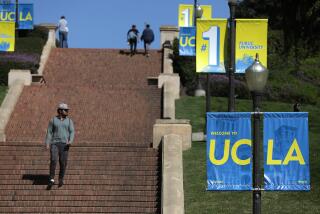Higher Education Isn’t Prepared for the Global Classroom
- Share via
NEW YORK — Increasingly, educators are meeting with cable operators; television, publishing, telephone, computer and software executives; and an assortment of entrepreneurs and their funders. What’s going on is the convergence of the information, education and digital ages in a way that will have a profound and growing impact on U.S. colleges and universities. Higher education must seize the moment or risk marginalization.
These visitors to academe generally talk about the same topic: distance learning and prospects for partnerships between colleges and their organizations. They need the content, reputation and credentialing higher education offers. In exchange, they bring deep pockets, advanced technology and an entrepreneurial spirit.
Distance learning, study away from traditional campuses, is hardly a new idea. Higher education began its first experiments with correspondence courses in the mid-19th century. Most recently, distance learning used television and computers. What’s new is the vast expansion of providers and technologies with capacities to reach previously unimaginable numbers of potential students and offer them customized education independent of the clock, anywhere around the globe.
Some academics see this as the dawning of a new era, akin to Johann Gutenberg’s invention of the printing press in the 1400s. Others worry that the combination of business interests, education and the prospect of educating electronically threatens to poison the traditions and values of academe. Still others view the exuberance over the new technology as a fad.
Whatever the spin, the chances for higher education to better serve a diverse clientele and the needs of an increasingly knowledge-based economy have never been greater. But we need to be fully cognizant of four inescapable, dramatic forces driving long-distance learning and be equally mindful of the risks they hold for colleges and universities:
* An information society puts a premium on intellectual capital. Since the half-life of knowledge is shorter than ever, there is increasing pressure to remain at the forefront of knowledge use and production. This requires education throughout a career and a corresponding rise in the use of continuing education or professional development. Without new technologies, we simply cannot satisfy this urgent need.
* Second, distance learning is being driven by changing demographics. The fastest-growing group attending colleges in the 1980s and ‘90s is working, part-time female students older than 25. Traditional students age 18 to 22, attending college full time and living on campus, make up less than one in five students. The new majority are seeking higher education principally to increase their salaries and advance their careers. They want convenience, service and quality. They are prime candidates for education delivered to their homes or offices.
* Which brings us to cost. Between 1980-1997, the average price of college tuition, room and board rose by more than 300%. Today, less than 5% of U.S. families can afford the full cost of a private-college education. Furthermore, there is a growing belief that public higher education is taking too big a bite out of state budgets. For these reasons, technology is being embraced as a vehicle for reducing the cost of education.
* Finally, the pervasiveness of advanced technology adds momentum to distance learning. It’s now possible to provide education directly to the homes of two of five U.S. families, thanks to PCs and modems. Millions of additional families around the world have access to the Internet.
The business community has been faster to respond to these four forces than colleges and universities. The imperative for higher education is to determine the ground rules by which a partnership with the private sector might best be accomplished. This requires a statement of essential purposes and core values of higher education.
If colleges and universities refuse to reexamine how they carry out their historic missions of research, teaching and service in a world of changing technology, the possibility of losing control over higher learning is as real as today’s Internet and tomorrow’s wired world. For the sake of meeting the aspirations of a new and expanding body of learners, as well as the nation itself, we simply cannot afford to let this happen.






